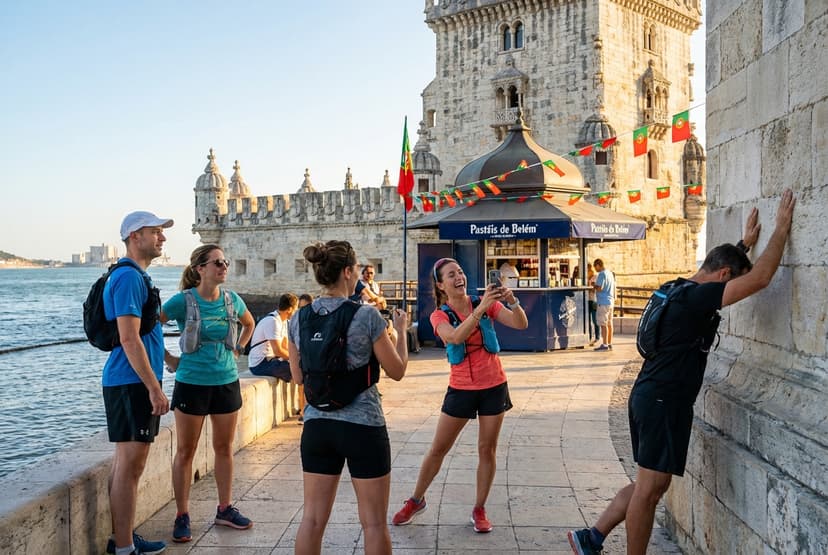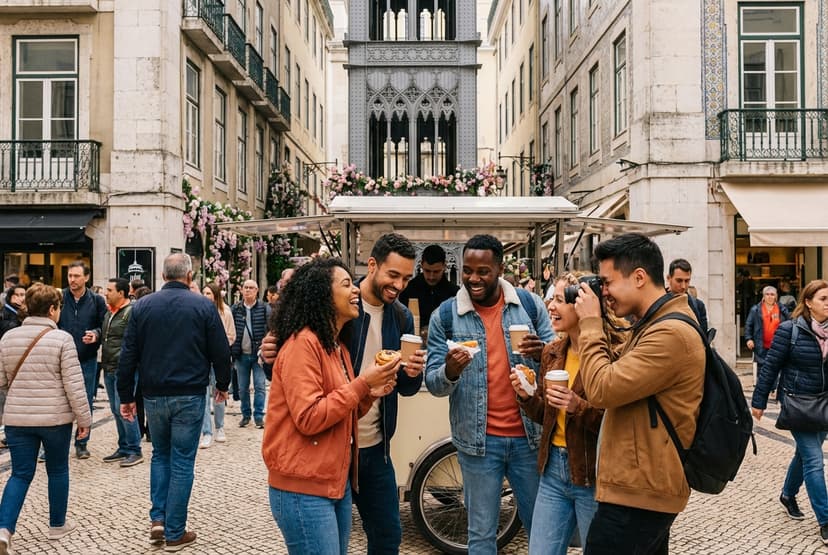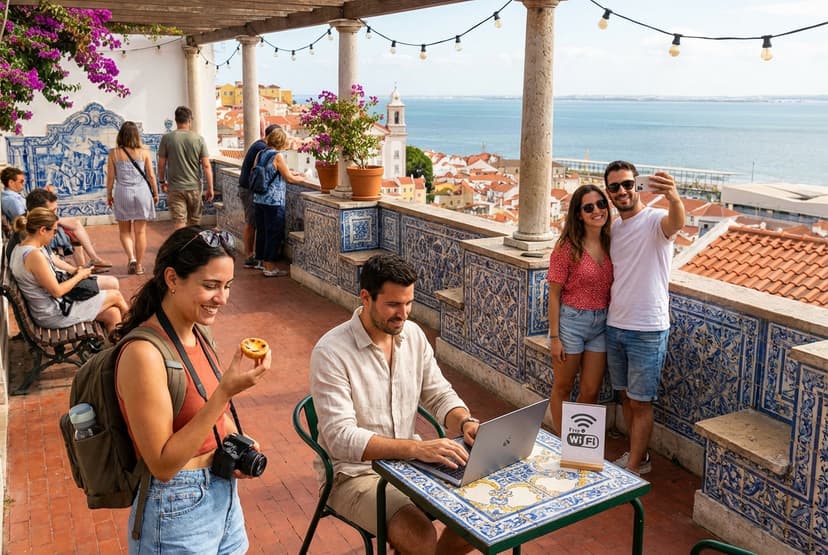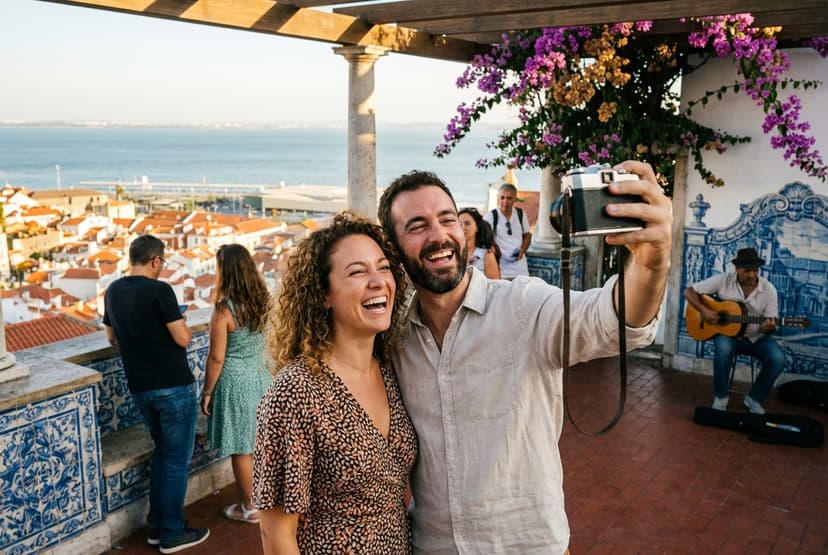Lisbon 3-Day Photography Itinerary — Sunrise & Sunset Focus
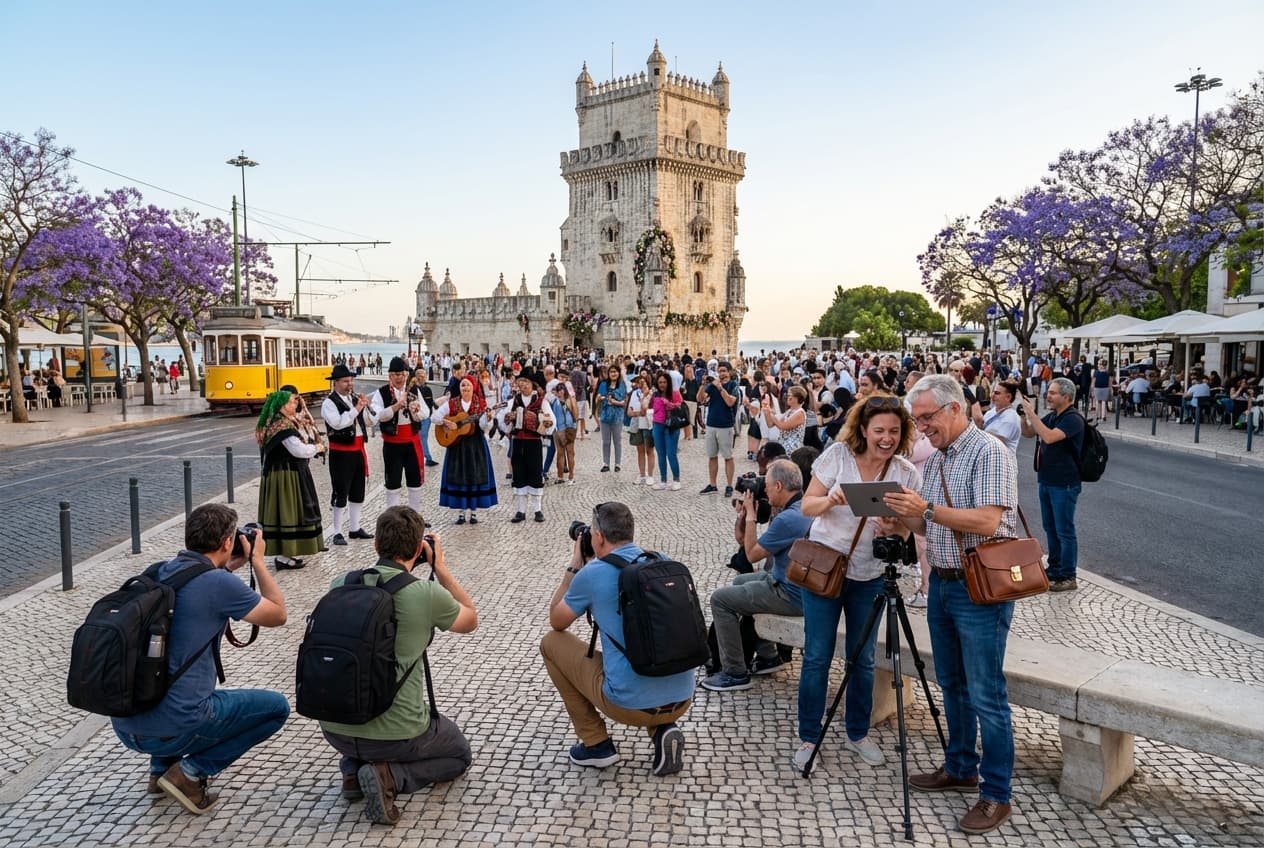
A photographer-focused 3-day plan in Lisbon (November / Autumn) emphasizing golden-hour sunrise and sunset viewpoints, tiled streets (azulejos), historic architecture, street art, and waterfront compositions. Balanced mix of iconic landmarks and local favorites with realistic pacing, meal breaks, and flexibility for spontaneous shoots.
Highlights
- Miradouros (city viewpoints) at sunrise & sunset
- Alfama's narrow tiled streets & rooftop panoramas
- Belém riverside monuments (Torre de Belém, Padrão dos Descobrimentos)
- MAAT modern curves and riverside reflections
- Museu Nacional do Azulejo — historic tiles up close
- LX Factory street art and industrial-chic textures
- Waterfront compositions at Cais das Colunas & Ribeira das Naus
Itinerary
Day 1
Historic core: Alfama, Baixa & Bica. Start early for sunrise over Alfama, then explore tiled alleys and hilltop viewpoints. Evening golden hour from Senhora do Monte and a relaxed market dinner.
Miradouro das Portas do Sol — Sunrise over Alfama
Capture sunrise light spilling over terracotta roofs, azulejo facades, and the Tagus in the background. Priority shoot for panoramic golden-hour cityscapes.
Tips from local experts:
- Arrive 20–30 minutes before sunrise to scout compositions (foreground rooftops, chimneys, tram lines). Best lenses: 24–70mm for panoramas, 70–200mm for compressed roof-details.
- This viewpoint can get people in the frame quickly — use a long exposure (ND + tripod) or a tight tele to isolate motifs. Tripods allowed outdoors; be mindful of pedestrian flow.
- Accessibility & crowd tip: There are some steep steps from the Alfama lanes; if mobility is a concern use the Rua dos Remédios approach. November mornings can be crisp — bring a windproof layer and spare batteries (cold reduces battery life).
Breakfast — Pois Café (Alfama)
Relaxed breakfast with indoor & window seating; good warm-up for editing shots and charging gear.
Tips from local experts:
- Pick a table by the window for natural light portraits or gear-cleanup shots; use this time to download and back up morning files.
- Peak seating is limited — arrive early. Coffee and pastries are fast; ask for a thicker mug to avoid spills near camera bags.
- To stay flexible: store a small kit (one camera + 35mm or 50mm) in a day bag for wandering Alfama after breakfast.
Wander Alfama — Narrow streets, azulejos & candid street scenes
Explore tiled facades, laundry lines, doorways, and intimate alley compositions. Focus on texture, color, and human-scale stories.
Tips from local experts:
- Use a 35mm or 50mm prime for environmental portraits and a 16–35mm for alleyways. Look for repeated tile patterns and details for abstract frames.
- Respect residents: ask permission quickly and briefly for portraits; many locals are used to cameras but a polite ‘Bom dia’ goes a long way.
- Low-traffic mid-morning is ideal in November — watch for wet cobbles after rain (great reflections) and bring rain protection for gear.
Castelo de São Jorge — Hilltop architecture & city panoramas
Historic castle ramparts provide elevated angles over Baixa and the river — useful for wide panoramas and telephoto compression shots.
Tips from local experts:
- Entry has a ticket fee; check castle opening hours and bring your student/professional IDs for any discounts. Tripods may be restricted in some areas — ask on arrival if you plan a tripod setup.
- Golden light and backlit silhouettes are excellent from the ramparts. Use graduated ND for balanced sky/foreground exposures, or bracket for HDR.
- Accessibility note: the site has cobbled, uneven surfaces and some steep climbs; use good walking shoes and allow extra time to move between vantage points.
Lunch — Chapitô à Mesa (rooftop views)
Lunch with a view near the castle — photogenic plates and a rooftop terrace good for scouting afternoon angles.
Tips from local experts:
- Book a table on the terrace if possible (limited space) for relaxed scouting of Awning/rooftop textures and candid skyline shots.
- Use the break to offload cards and recharge batteries; the venue has plugs but bring short extension leads just in case.
- If you’re doing a quick food shoot, request minimal props/plates for cleaner compositions; restaurant staff are usually cooperative for pro photographers if you ask.
Bica Funicular & Rua da Bica — Iconic steep street compositions
Photograph the famous funicular, tram rails, tiled facades, and steep perspective lines — great for motion blur shots of the tram.
Tips from local experts:
- For tram motion shots use slow shutter (1/10–1/30s) panning from a low tripod or hand-held with IBIS. Wide-angle + foreground cobbles gives strong leading lines.
- Elevador da Bica can be crowded; shoot from a side alley for cleaner frames or wait between runs for empty-frame images. Early afternoon is often less busy than late morning.
- Street access is narrow — use a compact tripod or monopod. Consider a neutral-density filter for creative long exposures on sunny afternoons.
Miradouro da Senhora do Monte — Sunset & blue hour panorama
Less crowded, expansive views for sunset over the city and river; ideal for golden-hour color and blue-hour city lights.
Tips from local experts:
- Arrive ~90 minutes before sunset to lock a foreground and plan bracketed exposures for the rapidly changing light in November.
- This spot faces west-southwest — ideal for November sunsets. Use a sturdy tripod and remote release for long exposures as streetlights come up.
- Alternative viewpoint if crowded: move a few minutes to Miradouro de Santa Luzia for a tighter framed Alfama/river composition.
Dinner — Time Out Market Lisboa (flexible dining & covered space)
Varied food stalls for quick refuel and indoor editing/download time; covered and lively for evening scouting.
Tips from local experts:
- Use the covered seating to offload cards, tether, and review evening captures. There are plenty of food options to satisfy different tastes quickly.
- If you want quieter seating for editing, head to the outer counters away from the central stalls; bring headphones for focus.
- Night shots tip: step outside to the Cais do Sodré waterfront after dinner for long-exposure river reflections and night tram silhouettes.
Night stroll — Cais das Colunas (short waterfront blue-hour shoot)
A quick, classic nighttime composition with the twin columns and river reflections — excellent for blue hour and long exposures.
Tips from local experts:
- Carry a small travel tripod for long exposures; guard your kit from passing pedestrians and keep gear close in the evening.
- Compose low to include the reflection pool and columns; a polarizer won't help at night, but try a 10–20s exposure to smooth small wake ripples.
- Safety & access: this area is well-lit but can be busy — keep camera strap over wrist and use a small crossbody bag for quick movement.
Day 2
Belém & MAAT day: monuments, modern architecture, and riverside golden-hour silhouettes. Evening at LX Factory for industrial textures and street art.
Torre de Belém — Morning light on the tower
Photograph the medieval tower with soft morning light hitting its limestone textures; good for details and wide compositions with the Tagus.
Tips from local experts:
- Torre de Belém charges an admission fee; check opening hours in November and buy tickets online to save time. Tripods are often limited inside — best to shoot exteriors for long-exposure river shots.
- Use a telephoto (70–200mm) to compress the tower against the river, and a wide-angle lens to include foreground rocks and tidal reflections.
- Crowd tip: early morning is quieter. For a silhouette, shoot just before or during sunrise with the water as a neutral foreground; watch for ferries causing ripples.
Breakfast — Pastéis de Belém
Famous pastry shop for a quick, iconic Portuguese breakfast — good people- and food-portrait opportunities.
Tips from local experts:
- This is a cultural essential and can be busy — either queue early (you’re already here for sunrise) or use the takeaway counter for quick shots.
- For food photography, ask for a plate on a table by the window; natural side light will render custard textures beautifully.
- Keep gear minimal while inside; staff and patrons appreciate unobtrusive shooting — candid bakery shots work well with a 35mm or 50mm prime.
Mosteiro dos Jerónimos — Manueline architecture close-ups
Detailed stone carvings, cloisters and grand façades — a playground for texture and pattern photography.
Tips from local experts:
- Entry to the monastery may require a ticket; check for any photography restrictions inside cloisters and nave. Tripods typically not allowed indoors without a permit.
- Use a mid-telephoto (50–135mm) to isolate sculptural details and a wide lens for courtyard arches. Overcast November light softens shadows for even exposures.
- Insider composition: shoot low from the cloister corners to emphasize repeating arches and leading lines; morning hours are quieter than midday.
MAAT — Modern curves & riverside reflections
MAAT's exterior offers dynamic curved forms and reflective surfaces — excellent for abstract architecture and minimal compositions at midday and late afternoon.
Tips from local experts:
- MAAT has an entrance fee for interior exhibits; rooftop/exterior access may be free depending on the day. Tripods inside exhibits are usually restricted — contact museum for professional shoots.
- Use polarizing and ND filters for reflections on the water and building surface; late afternoon can produce dramatic side-light emphasizing curves.
- For alternative angles, walk the river promenade both north and south of MAAT to capture form and city reflections from different perspectives.
Lunch — Darwin's Café (MAAT area)
Casual riverside lunch — quick edit station and rooftop vantage points for relaxed shooting.
Tips from local experts:
- Use the break to back up cards; MAAT area cafés often have plugs and wifi for quick file transfers.
- If the café has terrace seating, move there for shaded natural light if you need to tether and check exposures.
- Keep an eye on tide & ferry schedules while lunching — sudden light shifts and ferry wakes can change foreground compositions for later shots.
Afternoon riverside stroll — Jardim da Praça do Império & Belém waterfront
Explore the garden terraces and riverside lines — good for pattern shots, reflections, and leading lines toward monuments.
Tips from local experts:
- November light is softer; use it to render garden textures and formal geometry without harsh shadows. A 50mm or 85mm is great for compressed details.
- Walk westward along the river to scout late-afternoon compositions for the Padrão dos Descobrimentos sunset shot.
- Scout alternative compositions under trees and along the pavement for foreground framing if the main spots are busy at sunset.
Padrão dos Descobrimentos — Sunset silhouettes along the river
Monument silhouette against golden sky — strong graphic images at sunset and blue hour reflections on the river.
Tips from local experts:
- Arrive well before golden hour to choose a composition (side-on for depth, head-on for symmetry). Tripods are fine outdoors but be mindful of pedestrian areas.
- Use bracketing to handle the bright sky and dark monument; silhouettes can be enhanced by slightly underexposing the monument to maintain color in the sky.
- If the main plaza is busy, move west along the quay for lower vantage points and fewer people in foregrounds.
Transfer to LX Factory & Golden-hour street-art scouting
Quick transfer to LX Factory for industrial textures, murals, and evening compositions among hip shops and creative spaces.
Tips from local experts:
- Allow 25–45 minutes for taxi/tram depending on traffic; keep a compact kit ready for golden hour mural shots on arrival.
- LX Factory has many narrow alleys and murals — a 24–70mm is versatile here; later evening bring a fast prime for low light.
- If you find a mural you want to light longer, ask local shop owners for permission to shoot with lights or stands; they are often cooperative.
Dinner & night art — LX Factory
Dinner in the converted-industrial complex and post-dinner night shots of murals, neon signs and textured walls.
Tips from local experts:
- Best after-dark murals: look for backlit signs and reflective wet surfaces for moody shots. Use a tripod and a 35mm or 50mm for street portraits.
- If you want to photograph inside venues, ask owners for permission — many operators are supportive of photographers and might offer access to unique angles.
- Keep an eye on closing times of shops and galleries; November evenings are cooler so dress warmly and keep lens cloths handy for condensation.
Day 3
Tiles, central viewpoints, and final waterfront moments. Azulejos museum for close-up tile studies, central viewpoints for farewell panoramas, and a relaxed final dinner.
Sunrise — Cais das Colunas (Praça do Comércio waterfront)
Classic low-angle waterfront shots with the twin columns framing the river and sunrise reflections on wet stone.
Tips from local experts:
- Arrive before first light for subtle color and to capture wet pavement reflections; use a small travel tripod for low-angle compositions.
- Wide-angle (16–35mm) works great for including columns and vast sky; for intimate details use a 50mm to isolate textures in the foreground.
- Crowd tip: early November mornings are quiet. If you need a cleaner frame, move slightly east toward the river edge for alternate compositions.
Breakfast — Café A Brasileira (Chiado)
Historic café with classic interiors — good for portrait and environment shots in a timeless setting.
Tips from local experts:
- Sit near the windows for natural light and use a 50mm for intimate environmental portraits. The café can be busy; plan a short session and then continue exploring.
- Use the break to charge batteries and cull early-morning files. Keep a camera strap on when moving through crowded streets.
- Chiado has many stairways and cobbles — secure camera bags and use wrist/strap when shooting near edges.
Santa Justa Lift (Elevador de Santa Justa) — Vertical architecture shots
Photograph the ornate iron lift, its observation deck, and the city views from above; great for vertical framing and street-to-sky lines.
Tips from local experts:
- There is an access fee for the top platform — consider buying a ticket if you want the upper viewpoint. Tripods are impractical in tight queues, so a fast prime helps.
- Compose with leading lines of the lift cage and the street below; midday light from the south casts interesting shadows on the ironwork in November.
- If the queue is long, photograph the structure from Praça do Carmo for a different perspective and return during a quieter hour for the deck shots.
Transfer to Museu Nacional do Azulejo (Xabregas) — cross-city move
Travel to the tile museum to photograph centuries of azulejos in consistent indoor light; transfer ensures you arrive before midday light changes.
Tips from local experts:
- Allow ~40–50 minutes by public transit from Chiado to the museum; taxis are faster but account for traffic. Keep a compact kit for walking between stops.
- November weather can be changeable — carry a dry cover for your camera bag during the transfer.
- Use transit time to review shot lists and battery levels so you’re ready for the museum’s limited-tripod environment.
Museu Nacional do Azulejo — Tile studies & detail work
Dedicated time to study and photograph historic azulejos: close-ups, patterns, and large narrative panels. Controlled indoor light is perfect for texture.
Tips from local experts:
- There is an admission fee and interior tripod rules — usually small tripods or monopods may be allowed but check the museum’s policy and ask at reception if you plan extended setup.
- Bring a macro or short telephoto (90–200mm) for detail tile shots and a 24–70mm for room-scale compositions. Use a high-ISO capable body if tripods are restricted.
- Watch for reflective glass cases on some displays — use off-axis angles to minimize reflections or a polarizer where possible.
Lunch & recharge — light meal near the museum
Short lunch break and time to backup photos and rest before the afternoon waterfront session.
Tips from local experts:
- Pick a small nearby café for a quick, hot meal and a quiet place to offload and verify files on a laptop.
- If you have a portable SSD, make a second backup here — November daylight is short so preserving your files mid-trip is smart.
- Stretch and hydrate: longer shoots (especially with heavy gear) make small breaks valuable to maintain focus and steady hands.
Transfer back to Baixa / Ribeira das Naus waterfront
Return to central waterfront for afternoon light and riverside compositions leading to evening viewpoint.
Tips from local experts:
- Allow ~30–45 minutes to return depending on transport mode. Keep a small kit accessible for quick shoreline shots on arrival.
- Scout the quay for potential foregrounds (steps, bollards) that can add depth to evening river compositions.
- If energy allows, take a short tram ride along the river to discover alternate piers and less-photographed angles.
Ribeira das Naus — Waterfront composition & reflections
Capture geometry of the promenade, moored boats, and river reflections in the softer afternoon light.
Tips from local experts:
- Bring an ND filter for long-exposure smoothing of the river surface and to capture motion-blurred boats for painterly effects.
- Shoot low to include the river edge lines as leading foregrounds; telephoto frames work well to compress boats against the city beyond.
- Be mindful of tide and boat traffic schedules (ferries create wakes) — small wakes can add foreground movement if composed intentionally.
Miradouro de São Pedro de Alcântara — Sunset farewell panorama
Final golden-hour city panorama over Chiado and Baixa with the 25 de Abril bridge in the distance — perfect closing shot.
Tips from local experts:
- Arrive 60–90 minutes early to rehearse compositions and set up panoramic brackets for stitchable ultra-high-res images.
- Use a nodal slide or tripod head for seamless panoramas; November sunsets can be quick — stay ready to bracket exposures.
- If crowded, move slightly uphill along the garden to find quieter vantage points with similar sightlines and fewer people in frame.
Farewell Dinner — Sea Me - Peixaria Moderna (Cais do Sodré)
Contemporary seafood restaurant to toast the trip; space for a relaxed review of images and final notes.
Tips from local experts:
- Reserve a table in advance for a smoother finish to the day. Use ambient interior light for natural table-top food compositions (fast prime recommended).
- Post-dinner: step out to the Cais do Sodré quay for final night shots of boats and reflections if you still have energy.
- Final gear-tip: review backups and label folders tonight so you can return home organized; a short checklist prevents missing any important RAW files.
